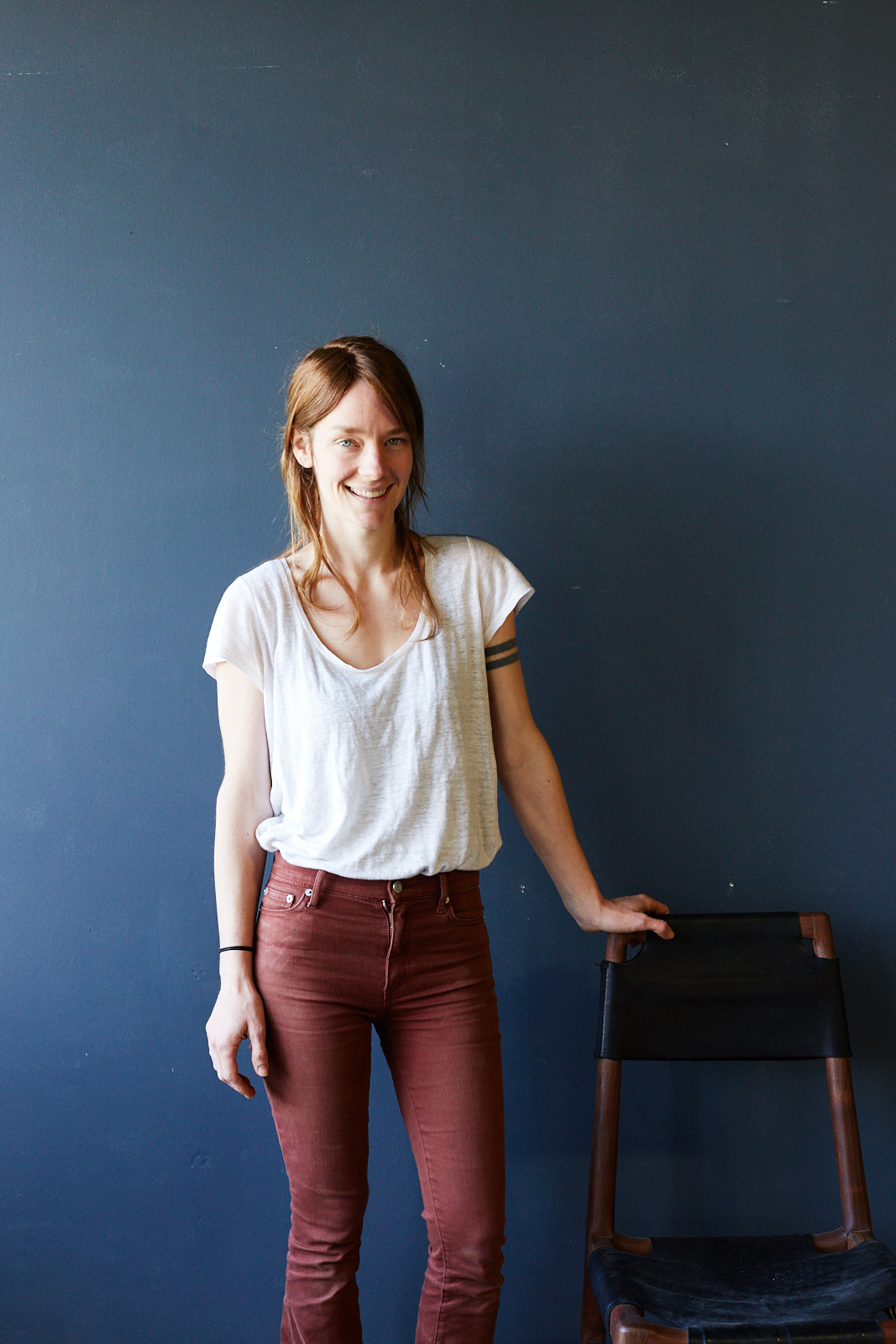It takes a certain breed of person to choose this sort of life – it comes with a lot of quirks and financial inconsistencies, and because of this the community is tight-knit and sticks together. It doesn’t seem uncommon that it can be sort of a family affair, with couples working alongside each other in some way, sharing resources and long hours.
— Casey Dzierlenga
Women have played a critical role in the woodworking sector for centuries, despite often sliding under the radar. Fortunately for us and the furniture industry as a whole, more women have begun to occupy a prominent space as woodworkers. Through our platform, we want to continue to help female woodworkers – like those you’re about to hear from – gain the exposure they deserve.
Q: You started in film and set design and then became a sculptor before starting your woodworking company. How did you find your way into making furniture?
A: I was working for a sculptor in east LA for a while, and then got the itch to pursue furniture, which is something I had always contemplated. I was on the verge of applying for a residency at Penland School of Crafts, in the mountains of NC, but figured I’d prowl the Craigslist listings in LA before I left to see if anything popped up. I stumbled upon an entry-level position working for Samuel Moyer Furniture in downtown LA, and basically learned the ropes building there. After a few years, I left to start my own company.
Q: What year did you officially launch your company, and how did you decide on the Hudson Valley as your home base?
A: I launched Dzierlenga F+U in 2012. Sam and I moved from Angelino Heights in Los Angeles across the country to an old farmhouse in the Hudson Valley. We were ready to get back to the East Coast and our families, as well as the seasons. The Hudson Valley is a great spot to be a craftsperson, largely due to cheap real estate and proximity to the city. We quickly embraced country life – raising chickens, goats, and bees, and eventually turning them all in for a human kid.
Q: One of the things we were first drawn to in your work is the way it celebrates the texture and aesthetics of the wood itself. And I love your description of how you aim to draw attention to the “wilder, mystical characteristics” of your material. Where and how do your source the wood you use, and how do you determine what shape each raw piece eventually takes?
A: I’m a bit of a wood hoarder. Whether it’s wood I’ve milled on the property, or something I’ve picked up at a lumberyard, I hold on to things until I feel like they’ll be properly justified by a specific project. My work often walks the line between wild and free and totally rectilinear, so I’m always looking for the right balance, and searching for a piece of wood that will bring a piece alive.
Q: What (if any) challenges have you faced as a female woodworker? Can you comment on the nature of women in the furniture industry more generally, and how you see it changing?
A: The first job I ever worked involved demoing brick patios and re-leveling driveways in North Carolina, so in my experience, getting puzzled, surprised looks from people sort of goes hand-in-hand with being employed.
I am hesitant to pinpoint that I’ve ever been treated differently because I’m a woman, but I have certainly had to negotiate hard for equal pay to some of my male counterparts. I’ve also noticed that local furniture jobs usually go to my husband. I think a lot of people, however well meaning, have an expectation that their custom furniture will be made by a wholesome bearded man. My husband happens to be a very charismatic bearded man, so it’s hard to say that my being female even has anything to do with it.
Among the community of furniture makers in Los Angeles, the Hudson Valley and North Carolina, there have always been rad, strong women, and I feel lucky to have known each and every one of them. It takes a certain breed of person to choose this sort of life – it comes with a lot of quirks and financial inconsistencies, and because of this the community is tight-knit and sticks together. It doesn’t seem uncommon that it can be sort of a family affair, with couples working alongside each other in some way, sharing resources and long hours. And I think women are largely celebrated for their work within that community.
The main issue is breaking through stereotypes of the clientele. I think social media is helping some with that, by giving people a look into the life behind the work, and allowing new, more personal narratives to be built.
Q: Where do you find your inspiration – for an individual piece or a collection – and what’s your typical process for turning it into a finished product?
A: For me, inspiration can really come from anywhere. It may be a spin-off of some antique I’ve seen, or a personal take on something modern I’ve spotted that I feel can be improved. Sometimes I start with the shape of the legs I want to turn, and sometimes it’s a color or a great piece of wood I have lying around. Sometimes there’s a sketch, and other times I just start building and see where I end up. I find I’m much better at beginning things than finishing them, so I often rely on deadlines from design shows (and clients!) to help keep me focused on following through with execution of new work.
Q: What are your thoughts on balancing “investment” pieces and accessible design – can they coexist, and how does one ensure that they do so harmoniously?
A: I’m thinking about this a lot lately. I love to think about regular people like us affording nice furniture. The tricky thing is that for us to achieve lower pricing, we have to remove ourselves from the work and automate somewhat. I did a recent collaboration with West Elm, which was great in that it did make one of my designs accessible to a wider clientele. I’d be interested to see what sort of pricing could be achieved by working with factories in the U.S., using domestic woods. I’ve always imagined approaching one of the High Point factories about doing a small run of furniture to test this idea. There are a lot of skilled workers in North Carolina who have been displaced by cheaper labor overseas, and I love the idea of reinvigoration that local industry and simultaneously expanding the accessibility of my designs.
Q: Do you think a lot about how your pieces will exist in someone’s home, after they leave your workshop?
A: If I know the person the piece is going to, I usually find myself thinking about this pretty much the entire time I’m making the piece. I’ve launched so many pieces of furniture out into the world, and have only had to address one or two repairs, which makes me happy. My husband has a hearty collection of antique heirlooms from his grandparents which fill our house, and it’s nice to think that I’m building a generation of heirlooms for my clients.
Q: What would you say to someone who is in the market for furniture and is debating about whether to shop from smaller designers in the Hudson Valley, for example, or from a global furniture company?
A: I think there are a number of considerations. Buying a piece made by a local artisan is a vote in support of local job creation, and a vote against the culture of disposability. When you work with a small maker, you can usually customize what you’re getting – what wood species is being used, the finish, etc. Most of the local makers I know use non-toxic finishes, and stay away from things like MDF that off-gas harmful chemicals over time.
You are also buying part of a larger story, or the body of work of the maker and/or a community of makers. Some of our clients really treat their furniture collections the same as one would an art collection, and value specific pieces for being part of a larger movement or history. This seems to be particularly true of the NYC/Hudson Valley movement that’s happening right now.
Q: Your husband is also a woodworker… Do you ever work together? Do your shared interests make it easier or more challenging to curate your home space?
A: Sheesh, that’s a tricky one. I think for me the shared interests make things more complicated. I sort of have a hermit crab approach to my old work – if I outgrow something, I leave it behind and don’t want it in my space anymore. I recently cut up my first rocking chair and threw it in the fire pit. Sam is a bit more sentimental, so he has a pretty large collection of old work and antiques from his family. It has been a bit of a balancing act to figure out how the two worlds can coexist – my more minimal modernism, and his more eclectic collection. We sometimes joke that we need to build him a museum to house things in.
Q: What designers do you follow? Are there other brands or companies whose designs you feel are particularly complementary to your own? (Other furniture brands, lighting designers, wallpaper companies, etc.)
A: We did some early shows with Michael Robbins, who’s a close friend and a fantastic furniture maker. I have some pieces that show well alongside his work, some of which appeared in Architectural Digest a while back as part of the feature on the Fair Showroom in the New York Design Center. Of course, I follow the work of the other local makers – Pacama, Fern, Sawkille and BDDW – but I actually try to tune out to a certain degree so that I keep some insulation between what I’m doing and what’s happening around me.





























